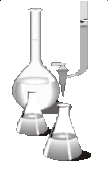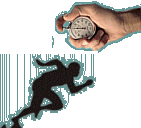


[Advertised Claims] [Description] [Commercial Availability and General Use] [Ergogenic Effects] [Risks and Disadvantages] [Recommendations]
| Advertised
Claims |
Creatine and its phosphorylated analogue, phosphocreatine, play important roles in the provision of energy during short-term, high-intensity exercise. Chemically, creatine is known as methylguanidine-acetic acid and is formed by the amino acids: arginine, glycine, and methionine. De novo synthesis of creatine occurs primarily in the liver and also occurs in the pancreas and the kidneys. The body of a 70-kg individual produces about 1 gram of creatine each day, and about 1.6% of the total creatine pool is turned over each day (1).
Creatine may also be obtained in the diet from foods such as meats and fish. 1-kg of uncooked steak contains about 4 grams of creatine. However, some of the creatine is degraded during the cooking process (2). The average person consumes about one gram of creatine each day from a regular diet (3).
Creatine is transported from its production sites and/or from digestion via the bloodstream to the skeletal muscles where 95% of it is stored (4). Skeletal muscle contains approximately 125 mmol of creatine/kg of muscle (dry mass). The body of a 70-kg individual would contain a total of about 120 g of creatine. Approximately 60% of the creatine exists in its phosphorylated form, phosphocreatine (also called creatine phosphate) (5).
This 2:3 ratio of creatine to phosphocreatine appears to be unaffected by training and is the same for all individuals regardless of body weight or gender. However, there appears to be a slightly higher ratio of phosphocreatine to creatine in Type II (fast twitch, white) fibers than in Type I (slow twitch, red) fibers (1, 6,7). The Type II fibers rely heavily on anaerobic pathways and phosphocreatine for ATP production, whereas Type I fibers have a much greater mitochondrial volume density and thus favor the oxidative pathways for energy production.
Creatine is eventually degraded into creatinine which is excreted by the kidneys. Creatinine is filtrated in the kidneys via passive diffusion thus its excretion does not require additional energy input. Excess creatine is also excreted in the urine through passive diffusion. Early studies indicated that most of the creatine is stored in the body since it did not appear in regular urine samples (8,9,10).
The primary purpose of phosphocreatine is to re-supply ADP with high-energy phosphates to buffer levels of ATP when ATP levels are falling rapidly as in intense exercise. ATP is the only direct source of energy that can be used by the cells. Glucose and free fatty acids are metabolized to eventually produce ATP which the cell utilizes to do work such as muscular contraction. Skeletal muscle fatigues if ATP levels fall below 25-30% of the normal level. Though ATP production is continually produced by the glycolytic and oxidative (the electron transport chain) mechanisms, short duration, high intensity activities can drain the stores of ATP faster than it can be supplied by those mechanisms.
Creatine phosphate then, acts as a reserve of high-energy phosphates. It transfers its phosphates to ADP to regenerate ATP while the glycolytic pathway is still "warming up" so to speak. Indeed, it has been shown in studies that phosphocreatine usage peaks within a third of the time it takes for glycolysis to peak (which takes about 3s). More specifically, creatine usage declines within 1.28 seconds during muscular contraction whereas glycolysis peaks at about 3 seconds during the contraction (2).
A further point of interest is that phosphocreatine levels are initially about three times greater than the ATP levels (about 75 mmol/kg dm of PCr as compared to 25 mmol/kg dm of ATP). This 3:1 ratio of phosphocreatine to ATP allows ATP to be regenerated from ADP at a faster rate than the ATP is depleted. Phosphocreatine would eventually be depleted in the cell within seconds (about 10 seconds) but is recharged from creatine while the cell is at rest (using ATP produced by the electron transport chain). About 50% of the phosphocreatine is regenerated within 30 seconds during the recovery period. About two to three minutes is required for all of the phosphocreatine to be replenished (11).
The transfer of phosphates between phosphocreatine and ADP is a reversible reaction catalyzed by the enzyme, creatine kinase.
![]()
The equilibrium of this reaction shifts according to the concentration of the substrates (ADP or creatine). The shifting of phosphates is often referred to as the "creatine shuttle".
| Commercial
Availability and General Use Creatine
is sold in the monohydrate form because that is the form most easily absorbed by the
digestive system. (The phosphate charge on creatine phosphate prevents it from being
absorbed easily across the intestinal epithelium.) It is available over the counter and is
sold as powders, fruit drinks, capsules, and candy. Cost is about $30 for a month’s
supply. (First time users may use up about a month’s supply within the first week
during the recommended "loading phase" described next.)
Standard method of intake is to consume 20 g of the creatine monohydrate each day in 4 divided doses (5 g/dose) during the first 5-7 days of intake. This is referred to as the "loading phase". The doses should be spread equally throughout the day to maximize absorption. Thereafter, the user needs to only take one dose of 2-5 g each day (any excess creatine would simply be excreted in the urine at this point). This is commonly referred to as the "maintenance phase". An alternative method of creatine intake is to consume 3 g of creatine each day for approximately 28 days for the loading phase. Recent research suggests that optimal results can be achieved by consuming the creatine supplement along with carbohydrates, particularly fast releasing glycolyzers such as fruit juices. Since those carbohydrates induce a rapid insulin response, insulin (a hormone of storage) may drive more of the creatine into the muscle cells. About 90 g of carbohydrates along with each dose of creatine monohydrate is sufficient to evoke the insulin response (12). |
Creatine kinase does not become saturated during the phosphorylation reaction. Furthermore, the body of an average person has a creatine level of about 125 mmol/kg of skeletal muscle tissue (dry mass). However, there appears to be an upper limit of about 150-160 mmol/ kg dm (2). This led researchers to believe that creatine levels can be augmented resulting in improved ability to perform short term, maximal exercises or sporting events that call upon short duration, high intensity bouts of activity.
Such activities and exercises drain the muscle cell’s supply of creatine very rapidly. By hyper-dosing on creatine for several days, one not only increases the initial reserves of creatine but also the initial amount of phosphocreatine in the muscle cells. Studies have shown that total creatine reserves increased on an average of 18.5% and phosphocreatine increased on an average of 20.7% (5).
But even more importantly, a higher concentration of creatine may increase the rate at which phosphocreatine can be resynthesized while the muscle cell is resting during the recovery period. This allows the muscles to perform highly intense bouts of activities with less fatigue and with shorter rest periods (11).
Research Studies
Many studies have shown an ergogenic effect of creatine supplementation for repeated bouts of high intensity exercise. These effects have been acknowledged and summarized in several recent reviews (1,2, 13-18). However, not all research trials have reported performance-enhancing effects of creatine. A few of the studies that have reported egrogenic effects resulting from creatine supplementation are descibed below. Most of the studies employed a standard protocol of 20-30 g of creatine monohydrate daily for 5-6 days.
- Peak torque increased during 5 bouts of 30 knee extensions on an isokinetic dynamometer (19).
- Athletes tested for strength and power increased peak power output in 5 sets of jump squats and increased in number of reps in 5 sets of bench presses (20).
- Athletes showed improved performance in 1000 m simulated rowing (21).
- Trained subjects improved average jumping height during a 45s continuous jumping test and improved treadmill time to exhaustion. (22).
- Football players consumed about 20 g creatine for 35 days. Bench press and squat performance increased by about 10.9% (23).
2) Increases muscle size:
There have been anecdotal reports of weight gain by as much as 2 to 5 lbs. within one to four weeks of creatine supplementation. Many researchers believe that some of this can be attributed to increased levels of water retention within the cells caused by osmotic pressure resulting from the creatine uptake.
It has been hypothesized that the intracellular water retention can cause the skeletal muscles to undergo hypertrophy. The water retention may cause the cell to become enlarged, and so the cell is able to synthesize more contractile protein particularly in the Type II fibers. Studies are currently examining how creatine metabolism plays a direct role in muscle protein anabolism (20).
3) Decreases muscle lactate:
Creatine may buffer muscle lactate levels and raise pH levels during exercise via two mechanisms. First of all, the phosphorylation reaction of ADP by phosphocreatine consumes hydrogen ions; thus it may reduce acid content in the muscles (24). Furthermore, the improved turnover rate of ATP caused by an increased level of creatine reduces the cell’s reliance on glycolysis. Therefore, less lactate is formed. This has been indicated in studies that observed lower muscle lactate levels and lower hypoxanthine levels after exercise (25). Hypoxanthine is a by-product of adenosine breakdown.
Risks and
Disadvantages
Note: Creatine supplementation does suppress the body's natural production of creatine. However, once supplementation is ceased, normal production is resumed within several weeks (4). |
RecommendationsCreatine monohydrate may be an effective supplement for those seeking to make gains in muscle strength and size through weight training. Also, it may benefit athletes involved in sports that call upon short term, high intensity movements such as the shot put or the 100 m run. However, creatine supplementation has not been shown to improve performance in long-distance/endurance type sports such cross country running or skiing. Little is known as to whether creatine supplements can improve performance in sports such as basketball or wrestling that mix endurance-type activities and "power" movements. This probably depends on the specific sport and the individual athlete.
|
| Update#1
05/07/98 In 1997, three collegiate wrestlers, each from different states, died within a five-week period while preparing for competition (16). There was intially some speculation that creatine use was responsible for the deaths of the wrestlers. However, autopsies indicated that the deaths were the direct result of hyperthermia induced by intentional dehydration and weight loss. All three wrestlers were reported to have used similar weight loss procedures for several weeks prior to the competition and intensified the procedues a few days before the competition (22). So far, there is no evidence that links creatine usage to the deaths. Whether creatine supplementation had any indirect role in aggravating the conditions of the athletes remains in question however. For more information on the postmortem studies of the wrestlers, see the following website: http://www.cdc.gov/epo/mmwr/mmr_wk.html The report on the wrestlers can be found in the Feb 20, 1998 section. Richard Chiang 5/7/98 22. Rapid weight loss in three collegiate wrestlers. MMWR Weeky Report Feb 20, 1997/vol. 47/no.6.
Update#2 04/21/00 The American College of Sports Medicine has recently published a review article that discusses some of the physiological and health effects of creatine supplementation. 28. Terjung RL, Clarkson P, Eichner R, Greenhaff P, Hespel PJ, Israel RG, Kraemer WJ, Meyer RA, Spreit LL, Tarnopolsky MA, Anton JM, Wagenmakers AJM, Williams MH. The physiological and health effects of oral creatine supplementation. Med Sci Sports Exerc. 2000;32:706-717.
|
2. Greenhaff PL. Creatine and its application as an ergogenic aid. Int J Sport Nutr. 1995;5 Suppl:S100-10.
3. Hoogwerf BJ, Laine DC, Greene E. Urine C-peptide and creatinine (Jaffe method) excretion in healthy young adults on varied diets: sustained effects of varied carbohydrate, protein, and meat content. Am J Cli Nutr. 1986;43:350-60.
4. Walker JB.
Creatine: biosynthesis, regulation and function. Adv Enzymol Relat Areas Mol
Biol 1979;50:177-242.
7. Soderlund K, Greenhaff PL, Hultman E. Energy metabolism in type I and type II human muscle fibres during short term electrical stimulation at different frequencies. Acta Physiol Scand. 1992;144:15-22.
13. Juhn MS, Tarnopolsky M. Oral creatine supplementation and athletic performance: a critical review. Clin J Sport Med. 1998;8:286-97.
14. Juhn MS. Oral creatine supplementation: separating fact from hype. Physician and sportsmedicine. 1999;27:47-61,89.
15. Williams MH, Branch JD. Creatine supplementation and exercise performance: an update. J Am Coll Nutr. 1998;17:216-34.
16. Toler SM. Creatine is an ergogen for anaerobic exercise. Nutr Rev. 1997;55:21-3.
17. Maughan RJ. Creatine supplementation and exercise performance. Int J Sport Nutr. 1995;5:94-101.
19. Greenhaff PL, Casey A, Short AH, Harris R, Soderlund K, Hultman E. Influence of oral creatine supplementation of muscle torque during repeated bouts of maximal voluntary exercise in man. Clin Sci (Colch). 1993;84:565-71.
20. Volek JS, Kraemer WJ, Bush JA, Boetes M, Incledon T, Clark KL, Lynch JM. Creatine supplementation enhances muscular performance during high-intensity resistance exercise. J Am Diet Assoc. 1997;97:765-70.
21. Rossiter HB, Cannell ER, Jakeman PM. The effect of oral creatine supplementation on the 1000-m performance of competitive rowers. J Sports Sci. 1996;14:175-9.
22. Bosco C, Tihanyi J, Pucspk J, Kovacs I, Gabossy A, Colli R, Pulvirenti G, Tranquilli C, Foti C, Viru M, Viru A. Effect of oral creatine supplementation on jumping and running performance. Int J Sports Med. 1997;18:369-72.
24. Harris RC, Soderlund K, Hultman E. Elevation of creatine in resting and exercised muscle of normal subjects by creatine supplementation. Clin Sci (Colch). 1992;83:367-74.
26. Delanghe J, De Slypere JP, De Buyzere M, Robbrecht J, Wieme R, Vermeulen A.
Normal reference values for creatine, creatinine, and carnitine are lower in vegetarians. Clin
Chem. 1989;35:1802-3.